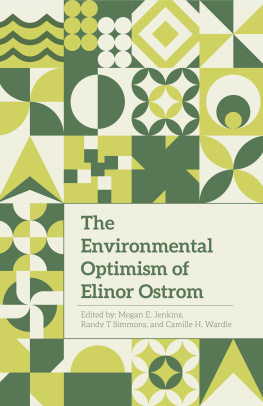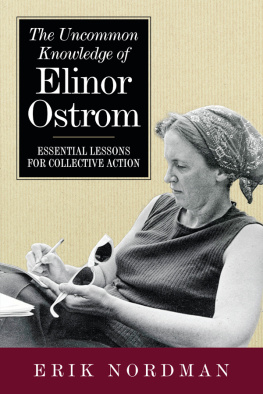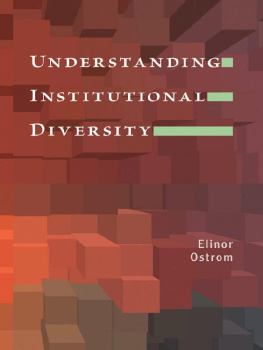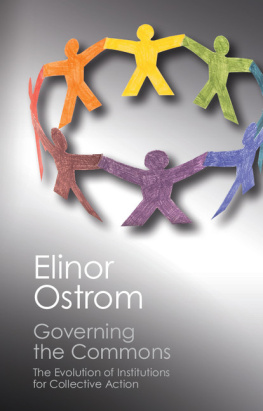Megan E. Jenkins (editor) - The environmental optimism of Elinor Ostrom
Here you can read online Megan E. Jenkins (editor) - The environmental optimism of Elinor Ostrom full text of the book (entire story) in english for free. Download pdf and epub, get meaning, cover and reviews about this ebook. year: 2020, genre: Politics. Description of the work, (preface) as well as reviews are available. Best literature library LitArk.com created for fans of good reading and offers a wide selection of genres:
Romance novel
Science fiction
Adventure
Detective
Science
History
Home and family
Prose
Art
Politics
Computer
Non-fiction
Religion
Business
Children
Humor
Choose a favorite category and find really read worthwhile books. Enjoy immersion in the world of imagination, feel the emotions of the characters or learn something new for yourself, make an fascinating discovery.
- Book:The environmental optimism of Elinor Ostrom
- Author:
- Genre:
- Year:2020
- Rating:5 / 5
- Favourites:Add to favourites
- Your mark:
- 100
- 1
- 2
- 3
- 4
- 5
The environmental optimism of Elinor Ostrom: summary, description and annotation
We offer to read an annotation, description, summary or preface (depends on what the author of the book "The environmental optimism of Elinor Ostrom" wrote himself). If you haven't found the necessary information about the book — write in the comments, we will try to find it.
The environmental optimism of Elinor Ostrom — read online for free the complete book (whole text) full work
Below is the text of the book, divided by pages. System saving the place of the last page read, allows you to conveniently read the book "The environmental optimism of Elinor Ostrom" online for free, without having to search again every time where you left off. Put a bookmark, and you can go to the page where you finished reading at any time.
Font size:
Interval:
Bookmark:
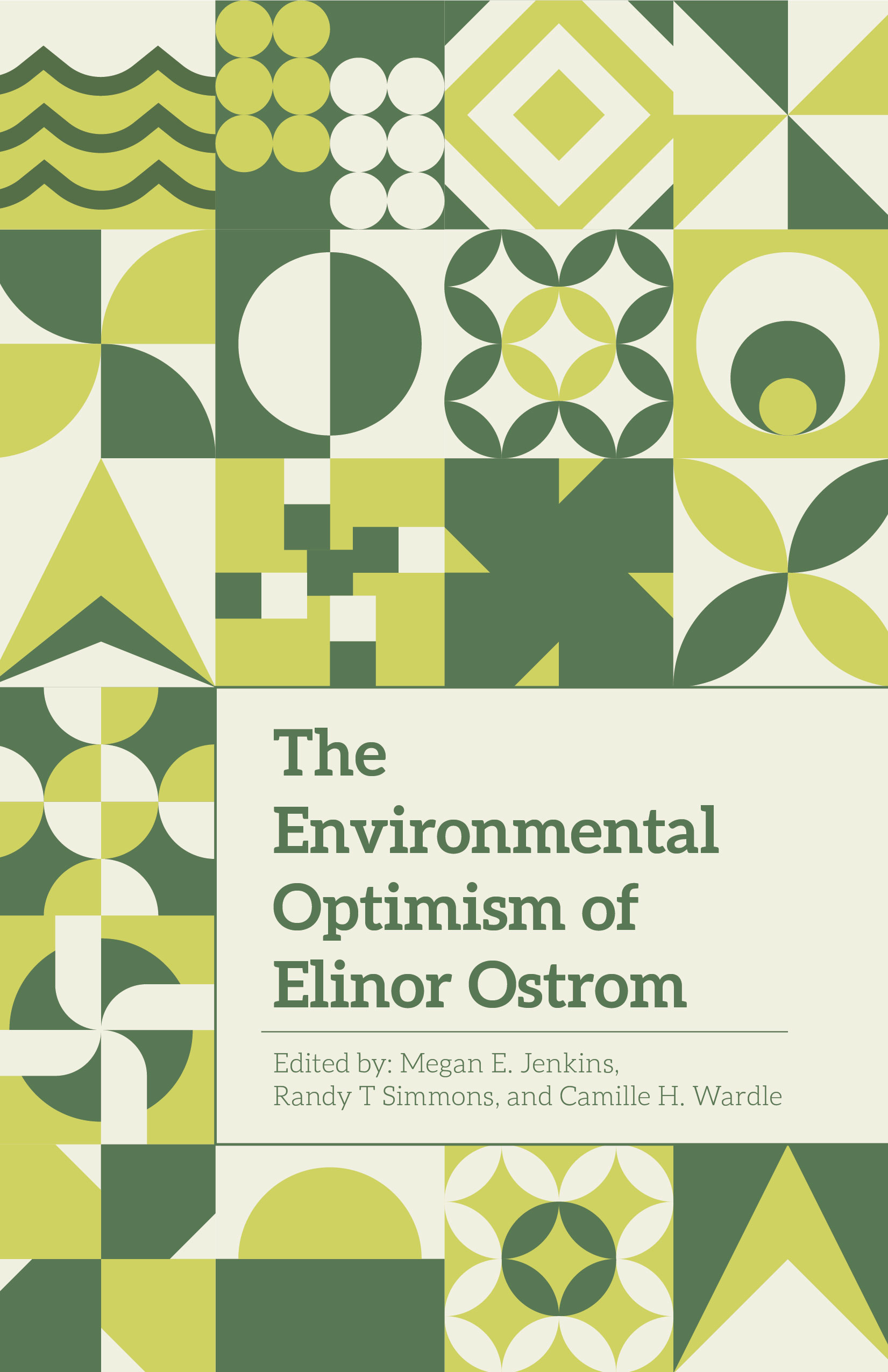

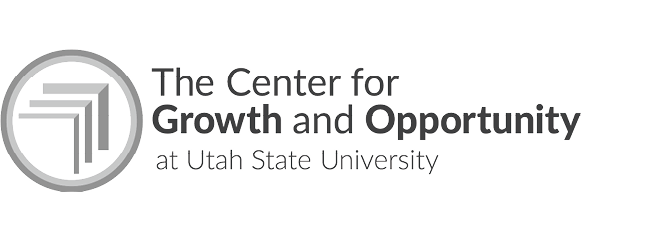
Copyright 2020 the Center for Growth and Opportunity at Utah State University
All rights reserved
Paperback ISBN 978-1-7348561-0-1
eISBN 978-1-7348561-1-8
Cover design and typesetting by Brooke Jacques
The Center for Growth and Opportunity at Utah State University 3525 Old Main Hill Logan, UT 84322 www. thecgo.org

Introduction
Megan E. Jenkins and Randy T Simmons
U tah State University has had a long-term involvement in water resources management in the Dominican Republic. A few years ago one of us (Randy Simmons) visited the Dominican Republics National Institute for Water Resources. Behind a counter on the main floor of their offices, an entire wall was taken up by a map of the country, showing its nearly five thousand kilometers of irrigation canals and fourteen major dams. When asked how this system was managed, one of the water managers answered with a question: Have you ever heard of Elinor Ostrom? They were implementing her framework as they transferred management authority from the central government to local water-user associations.
The Dominican experiment in irrigation management illustrates a key point in the Ostromian approach, because the management system is neither purely public nor purely private. It is polycentricthat is, there are overlapping jurisdictions with multiple decision-making centers. Social scientists use the term social dilemma to label situations in which there is conflict between individual and collective interests. Historically, there have been two basic ways of looking at such situations: a pessimistic point of view and an optimistic point of view. The pessimistic viewthat individuals are helplessly trappedwas dominant in the past, and often still seems so. Ostroms approach is so much more optimistic than this.
The most influential statement of pessimism about social dilemmas was Garrett Hardins 1968 article, The Tragedy of the Commons. Hardin claimed, The inherent logic of the commons remorselessly generates tragedy.... Ruin is the destination toward which all men rush, each pursuing his own best interest in a society that believes in the freedom of the commons. Freedom in a commons brings ruin to all. Many reacted to Hardin by proposing either government management or privatization of commons and commons-like resources. Ostrom and her colleagues helped researchers understand that there is a broad array of potential management schemes for resources held in common; the choice is not limited to purely public or purely private solutions.
As Ostrom explained in her Nobel lecture, What have we learned? We now know that the earlier theories of rational, but helpless, individuals who are trapped in social dilemmas are not supported by a large number of studies using diverse methods.
The essays in this volume are in the Ostromian tradition of exploring and attempting to understand complex institutional forms. Each chapter explores a particular issue in environmental policy by carefully analyzing how institutions impact the incentive to help or hinder the innovativeness, learning, adapting, trustworthiness, levels of cooperation of participants, and the achievement of more effective, equitable, and sustainable outcomes at multiple scales.
The diversity of topics studied in this volume serves as a tribute to the wide applicability of the foundational research Elinor Ostrom conducted. The volume begins with an examination of resource governance in the American West, looking at how top-down institutions developed to govern a complex and demanding landscape that new settlers were unaccustomed to. It then explores another example from the western United States: that of the largely successful polycentric management of the greater sage-grouse. The third chapter explores the role of American and Canadian indigenous groups in governing Pacific salmon fisheries. Chapter 4 moves on to an examination of Garrett Hardins classic, The Tragedy of the Commons, and of Ostroms response to Hardins claim that unchecked human population growth is a recipe for tragedy. The fifth chapter bridges the gap between the work of natural resources scholar and University of California Santa Barbara professor Gary Libecap on property rights and Ostroms work on polycentric governance. And the sixth and final chapter explores the importance of long-distance trade in developing markets for industrial by-products, and thus in cleaning up the commons.
Although the chapters included here span diverse areas of study, several common themes emerge. The first is Elinor Ostroms core finding that one-size-fits-all solutions cannot adequately address complex local conditions. Environmental issues tend to be complex, and solving them requires robust local knowledge and cooperation among on-the-ground actors. The chapters in this volume explore this theme by examining how settlers in the American West decided to allocate water and grazing rights as well as how indigenous groups work with national and international organizations to effectively manage salmon in the Pacific.
Another common theme is that human ingenuity and creativity are limitless. Garrett Hardin predicted that population growth would inevitably result in environmental catastrophe as human beings outstripped the earths ability to keep them alive. But, as the authors of this volume point out, population growth has led to exponential increases in wealth, an increasing ability to produce greater amounts of food, and the development of life-saving and life-improving technologies. The case studies explored throughout this volume, from managing sage-grouse to developing markets that turn waste products into valuable by-products, demonstrate humans limitless ability to work together to find creative solutions to environmental problems.
If we have learned anything about how to get better environmental outcomes, it is that institutions truly matter. The chapters here all shed light on how institutional design impacts whether local actors will cooperate to find mutually beneficial outcomes, or whether they will resort to conflict to get their desired outcome at the expense of someone else. Property rights, the enforcement of contracts, and cultural factors like trust all play an important role, and each of these institutions is explored in this volume.
Taken together, the work in this volume suggests that Elinor Ostrom was rightwe dont have to choose between purely private or purely public responses to environmental problems. In fact, many problems will be best addressed by a solution that combines the best of both types of responses by allowing for polycentric governance at multiple levels. Environmental issues will continue to be complex and ever-changing, and may only increase in scale. Addressing these issues will require harnessing the limitless ingenuity of humankind to find innovative solutions to new problems. And the only way to fully harness that ingenuity will be to allow human beings to experiment, to try new approaches, to fail, to learn from that failure, and to work together.
Chapter 1
Resource Governance in the American West: Institutions, Information, and Incentives
Font size:
Interval:
Bookmark:
Similar books «The environmental optimism of Elinor Ostrom»
Look at similar books to The environmental optimism of Elinor Ostrom. We have selected literature similar in name and meaning in the hope of providing readers with more options to find new, interesting, not yet read works.
Discussion, reviews of the book The environmental optimism of Elinor Ostrom and just readers' own opinions. Leave your comments, write what you think about the work, its meaning or the main characters. Specify what exactly you liked and what you didn't like, and why you think so.

